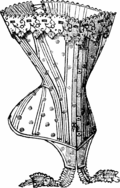Construction
Corsets are typically constructed of a flexible material (like cloth, particularly coutil, or leather) stiffened with boning (also called ribs or stays) inserted into channels in the cloth or leather. In the 19th century, steel and whalebone were favored for the boning. Featherbone was used as a less expensive substitute for whalebone and was constructed from flattened strips of goose quill woven together with yarn to form a long strip (Doyle, 1997:232). Plastic is now the most commonly used material for lightweight corsets, whereas spring or spiral steel is preferred for stronger corsets. Other materials used for boning include ivory, wood, and cane. (By contrast, a girdle is usually made of elasticized fabric, without boning.)
The craft of corset construction is known as corsetry, as is the general wearing of them. Someone who makes corsets is a corsetier (for a man) or corsetière (for a woman), or sometimes simply a corsetmaker. (The word corsetry is sometimes also used as a collective plural form of corset.)
Corsets are held together by lacing, usually (though not always) at the back. Tightening or loosening the lacing produces corresponding changes in the firmness of the corset. Depending on the desired effect and time period, corsets can be laced from the top down, from the bottom up or two laces were used to lace up from the bottom and down from the top to meet in the middle. It is difficult — although not impossible — for a back-laced corset-wearer to do his or her own lacing. In the Victorian heyday of corsets, a well-to-do woman would be laced by her maid, and a gentleman by his valet. However, many corsets also had a buttoned or hooked front opening called a busk. Once the lacing was adjusted comfortably, it was possible to leave the lacing as adjusted and take the corset on and off using the front opening (this method can potentially damage the busk if the lacing is not significantly loosened beforehand). Self-lacing is also almost impossible with tightlacing, which strives for the utmost possible reduction of the waist. Current tightlacers, lacking servants, are usually laced by spouses and partners.
Source from : http://en.wikipedia.org/wiki







No comments:
Post a Comment